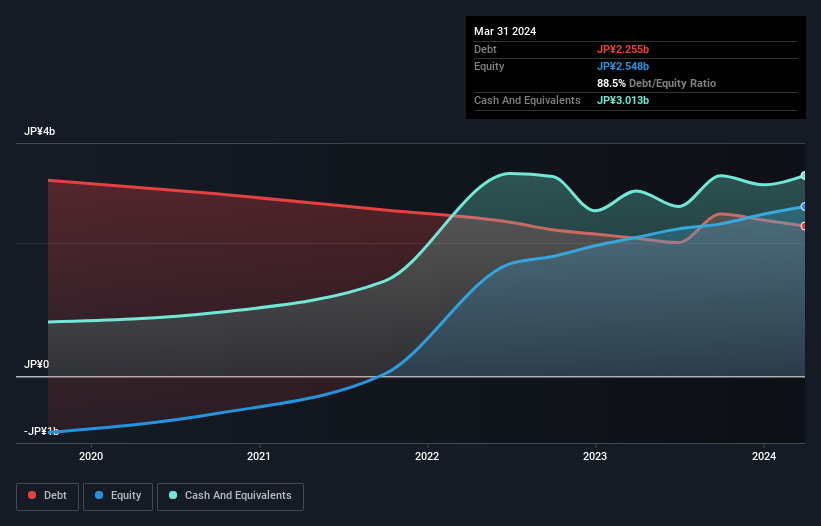- Japan
- /
- Food and Staples Retail
- /
- TSE:9259
We Think TAKAYOSHI Holdings (TSE:9259) Can Stay On Top Of Its Debt

Legendary fund manager Li Lu (who Charlie Munger backed) once said, 'The biggest investment risk is not the volatility of prices, but whether you will suffer a permanent loss of capital.' So it might be obvious that you need to consider debt, when you think about how risky any given stock is, because too much debt can sink a company. We can see that TAKAYOSHI Holdings, INC. (TSE:9259) does use debt in its business. But should shareholders be worried about its use of debt?
When Is Debt A Problem?
Debt assists a business until the business has trouble paying it off, either with new capital or with free cash flow. In the worst case scenario, a company can go bankrupt if it cannot pay its creditors. However, a more common (but still painful) scenario is that it has to raise new equity capital at a low price, thus permanently diluting shareholders. Having said that, the most common situation is where a company manages its debt reasonably well - and to its own advantage. When we think about a company's use of debt, we first look at cash and debt together.
See our latest analysis for TAKAYOSHI Holdings
What Is TAKAYOSHI Holdings's Net Debt?
As you can see below, at the end of March 2024, TAKAYOSHI Holdings had JP¥2.26b of debt, up from JP¥2.07b a year ago. Click the image for more detail. But on the other hand it also has JP¥3.01b in cash, leading to a JP¥758.0m net cash position.

How Healthy Is TAKAYOSHI Holdings' Balance Sheet?
Zooming in on the latest balance sheet data, we can see that TAKAYOSHI Holdings had liabilities of JP¥3.71b due within 12 months and liabilities of JP¥1.72b due beyond that. Offsetting these obligations, it had cash of JP¥3.01b as well as receivables valued at JP¥1.54b due within 12 months. So its liabilities total JP¥879.0m more than the combination of its cash and short-term receivables.
TAKAYOSHI Holdings has a market capitalization of JP¥3.31b, so it could very likely raise cash to ameliorate its balance sheet, if the need arose. But it's clear that we should definitely closely examine whether it can manage its debt without dilution. Despite its noteworthy liabilities, TAKAYOSHI Holdings boasts net cash, so it's fair to say it does not have a heavy debt load!
But the other side of the story is that TAKAYOSHI Holdings saw its EBIT decline by 5.0% over the last year. That sort of decline, if sustained, will obviously make debt harder to handle. There's no doubt that we learn most about debt from the balance sheet. But it is future earnings, more than anything, that will determine TAKAYOSHI Holdings's ability to maintain a healthy balance sheet going forward. So if you want to see what the professionals think, you might find this free report on analyst profit forecasts to be interesting.
Finally, a company can only pay off debt with cold hard cash, not accounting profits. While TAKAYOSHI Holdings has net cash on its balance sheet, it's still worth taking a look at its ability to convert earnings before interest and tax (EBIT) to free cash flow, to help us understand how quickly it is building (or eroding) that cash balance. Over the most recent three years, TAKAYOSHI Holdings recorded free cash flow worth 52% of its EBIT, which is around normal, given free cash flow excludes interest and tax. This free cash flow puts the company in a good position to pay down debt, when appropriate.
Summing Up
While TAKAYOSHI Holdings does have more liabilities than liquid assets, it also has net cash of JP¥758.0m. So we are not troubled with TAKAYOSHI Holdings's debt use. When analysing debt levels, the balance sheet is the obvious place to start. But ultimately, every company can contain risks that exist outside of the balance sheet. These risks can be hard to spot. Every company has them, and we've spotted 2 warning signs for TAKAYOSHI Holdings you should know about.
If, after all that, you're more interested in a fast growing company with a rock-solid balance sheet, then check out our list of net cash growth stocks without delay.
Valuation is complex, but we're here to simplify it.
Discover if TAKAYOSHI Holdings might be undervalued or overvalued with our detailed analysis, featuring fair value estimates, potential risks, dividends, insider trades, and its financial condition.
Access Free AnalysisHave feedback on this article? Concerned about the content? Get in touch with us directly. Alternatively, email editorial-team (at) simplywallst.com.
This article by Simply Wall St is general in nature. We provide commentary based on historical data and analyst forecasts only using an unbiased methodology and our articles are not intended to be financial advice. It does not constitute a recommendation to buy or sell any stock, and does not take account of your objectives, or your financial situation. We aim to bring you long-term focused analysis driven by fundamental data. Note that our analysis may not factor in the latest price-sensitive company announcements or qualitative material. Simply Wall St has no position in any stocks mentioned.
Have feedback on this article? Concerned about the content? Get in touch with us directly. Alternatively, email editorial-team@simplywallst.com
About TSE:9259
Flawless balance sheet with solid track record.


